Analyzing AI and Technology in Health Care Policy & Practice NHS
VerifiedAdded on 2022/12/23
|18
|4466
|77
Report
AI Summary
This report examines the transformative potential of new technology and artificial intelligence (AI) in healthcare, focusing on areas from chronic disease management to medical diagnostics. While AI offers benefits such as improved diagnostic accuracy and personalized treatment, its adoption within the National Health Service (NHS) has been slow due to factors like top-down innovation approaches and data compliance concerns. The report analyzes the use of AI in medical imaging, diabetic retinopathy detection, and patient self-management through digital tools. It also highlights the importance of data utilization and infrastructure development to support AI implementation. Recommendations include fostering co-production of solutions, addressing digital literacy gaps, and developing chief innovation officer roles to drive technology adoption in health and social care settings. The report concludes that embracing these technologies is crucial for improving healthcare efficiency and patient outcomes.
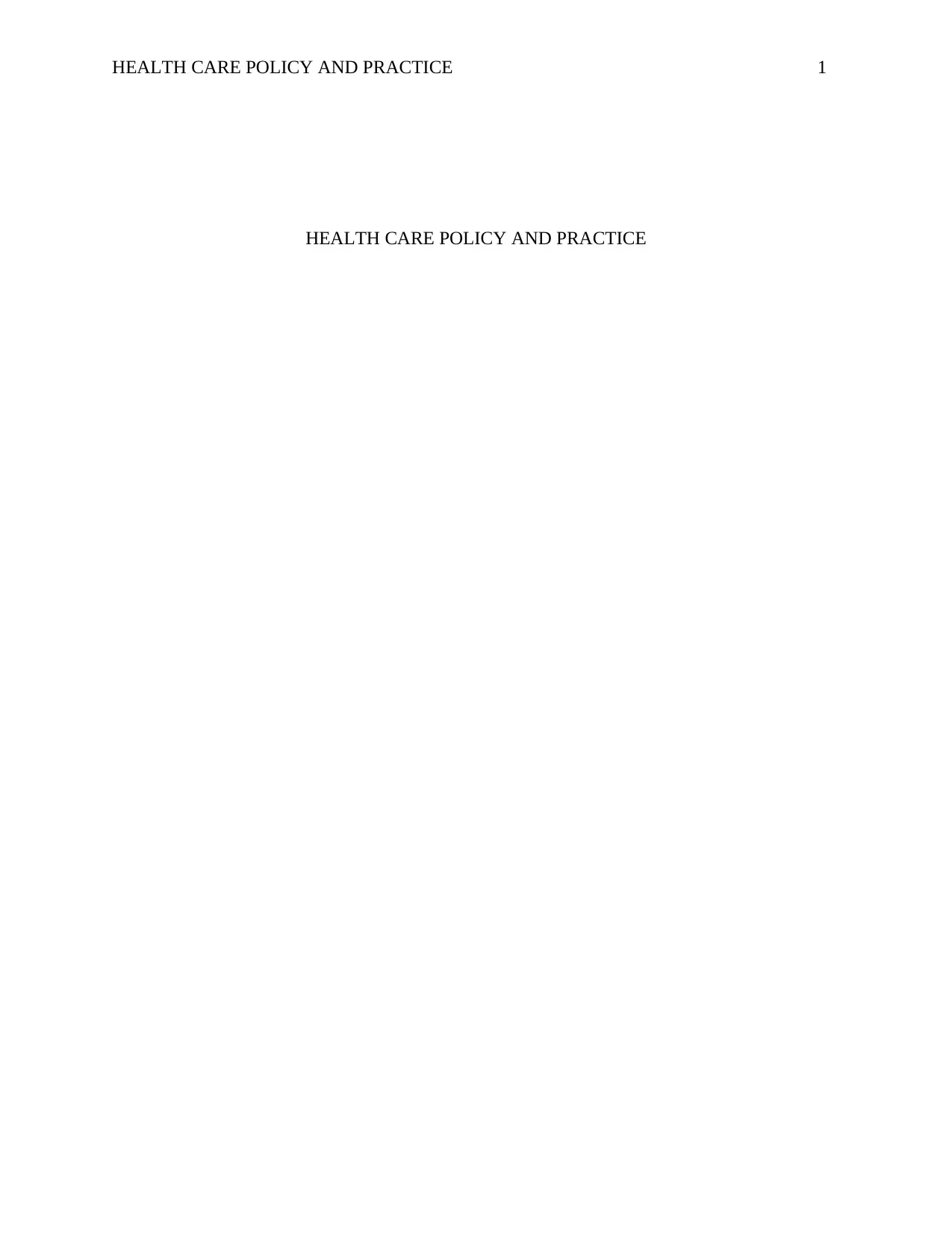
HEALTH CARE POLICY AND PRACTICE 1
HEALTH CARE POLICY AND PRACTICE
HEALTH CARE POLICY AND PRACTICE
Paraphrase This Document
Need a fresh take? Get an instant paraphrase of this document with our AI Paraphraser
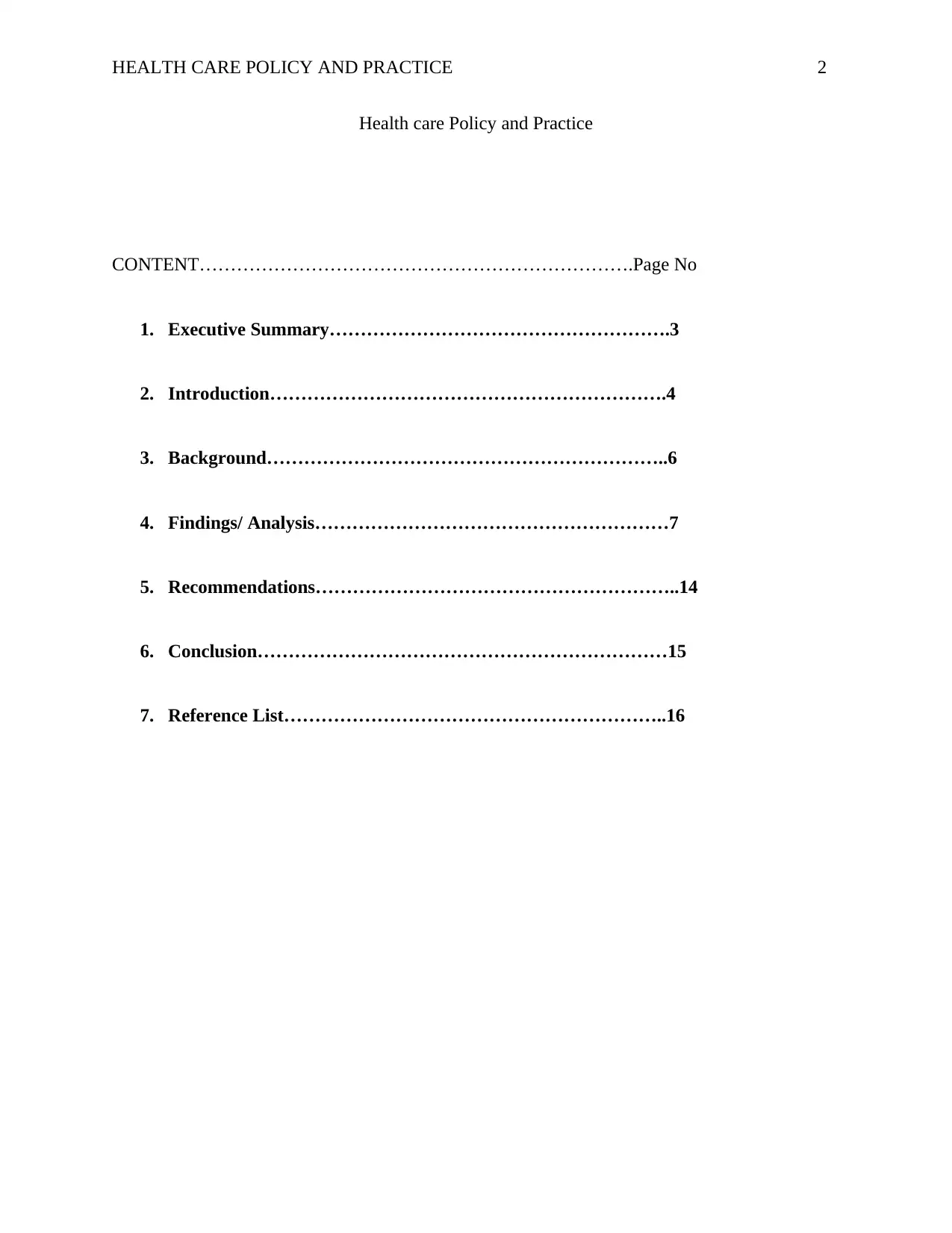
HEALTH CARE POLICY AND PRACTICE 2
Health care Policy and Practice
CONTENT…………………………………………………………….Page No
1. Executive Summary……………………………………………….3
2. Introduction……………………………………………………….4
3. Background………………………………………………………..6
4. Findings/ Analysis…………………………………………………7
5. Recommendations…………………………………………………..14
6. Conclusion…………………………………………………………15
7. Reference List……………………………………………………..16
Health care Policy and Practice
CONTENT…………………………………………………………….Page No
1. Executive Summary……………………………………………….3
2. Introduction……………………………………………………….4
3. Background………………………………………………………..6
4. Findings/ Analysis…………………………………………………7
5. Recommendations…………………………………………………..14
6. Conclusion…………………………………………………………15
7. Reference List……………………………………………………..16

HEALTH CARE POLICY AND PRACTICE 3
1. Executive Summary
The report focuses on how new technology and practices under the umbrella of artificial
intelligence can help improve the health and social care. There are advanced digital tools that
forms the foundation of artificial intelligence that when fully adopted can help in the
advancement in the field of science including public health and medicine. Demonstrations
from various health researches has been published as evidence on what these digital tools and
artificial intelligence can help in the management of chronic conditions such as asthma,
diabetes and cancer (Waterson, 2014). A variety of recent studies have tried to show how the
adoption of these digital tools in health care settings can help in delivery of health care
services. A good example of a way of advancement in technology is the artificial
intelligence based tools that are already being utilized in health oriented apps on network
devices like mobile phones.
1. Executive Summary
The report focuses on how new technology and practices under the umbrella of artificial
intelligence can help improve the health and social care. There are advanced digital tools that
forms the foundation of artificial intelligence that when fully adopted can help in the
advancement in the field of science including public health and medicine. Demonstrations
from various health researches has been published as evidence on what these digital tools and
artificial intelligence can help in the management of chronic conditions such as asthma,
diabetes and cancer (Waterson, 2014). A variety of recent studies have tried to show how the
adoption of these digital tools in health care settings can help in delivery of health care
services. A good example of a way of advancement in technology is the artificial
intelligence based tools that are already being utilized in health oriented apps on network
devices like mobile phones.
⊘ This is a preview!⊘
Do you want full access?
Subscribe today to unlock all pages.

Trusted by 1+ million students worldwide

HEALTH CARE POLICY AND PRACTICE 4
2. Introduction
The term Artificial is used together with the computing technologies to help in processes that
are associated with human intelligence like learning and reasoning. Artificial intelligence (AI) is
a widely used tool that enables many people to rethink on how they can analyze data and
integrate the information which leads to improvement in decision making thereby transforming
life.
There is a range of applications features that are contemporary to artificial technologies.
These Artificial Intelligence applications are currently being used in healthcare research and
research purposes including management of chronic disorders, drugs discovery, and detection of
illnesses and delivery of quality health care services. The artificial intelligence can help in the
address of some of the healthcare and social issues that we face today. Artificial Intelligence has
been around for many years, but it has promises that have remained unfulfilled.
This report provides the benefits of new technology and artificial intelligence in health and
social care in my area. Besides, the report offers some recommendation in which the progress in
the adoption of new technology and artificial intelligence can be facilitated. Furthermore, the
report presents conclusions and possible recommendations on the merits of the introduction of
new technology together with artificial intelligence in health care in my area of residence
(Zhivan and Diana, 2012).
It is sometimes hard to predict how technological advances will interact with healthcare
services and policy practices to shape the future of health and social care. In some health care
organizations, the use of modern technology has been partially adopted. With the complete
adoption of digital technology, the four main current trends may have a potential improvement in
2. Introduction
The term Artificial is used together with the computing technologies to help in processes that
are associated with human intelligence like learning and reasoning. Artificial intelligence (AI) is
a widely used tool that enables many people to rethink on how they can analyze data and
integrate the information which leads to improvement in decision making thereby transforming
life.
There is a range of applications features that are contemporary to artificial technologies.
These Artificial Intelligence applications are currently being used in healthcare research and
research purposes including management of chronic disorders, drugs discovery, and detection of
illnesses and delivery of quality health care services. The artificial intelligence can help in the
address of some of the healthcare and social issues that we face today. Artificial Intelligence has
been around for many years, but it has promises that have remained unfulfilled.
This report provides the benefits of new technology and artificial intelligence in health and
social care in my area. Besides, the report offers some recommendation in which the progress in
the adoption of new technology and artificial intelligence can be facilitated. Furthermore, the
report presents conclusions and possible recommendations on the merits of the introduction of
new technology together with artificial intelligence in health care in my area of residence
(Zhivan and Diana, 2012).
It is sometimes hard to predict how technological advances will interact with healthcare
services and policy practices to shape the future of health and social care. In some health care
organizations, the use of modern technology has been partially adopted. With the complete
adoption of digital technology, the four main current trends may have a potential improvement in
Paraphrase This Document
Need a fresh take? Get an instant paraphrase of this document with our AI Paraphraser
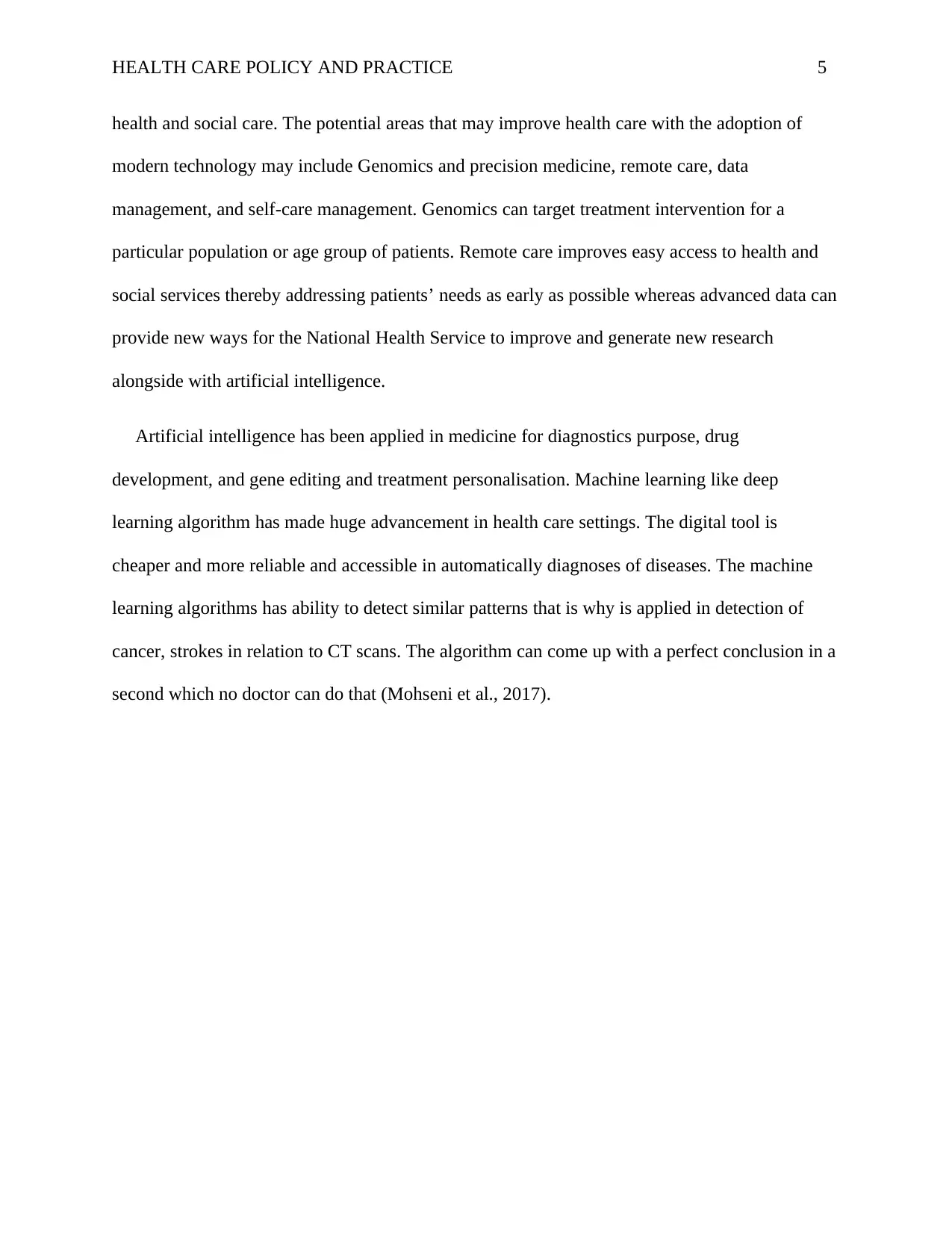
HEALTH CARE POLICY AND PRACTICE 5
health and social care. The potential areas that may improve health care with the adoption of
modern technology may include Genomics and precision medicine, remote care, data
management, and self-care management. Genomics can target treatment intervention for a
particular population or age group of patients. Remote care improves easy access to health and
social services thereby addressing patients’ needs as early as possible whereas advanced data can
provide new ways for the National Health Service to improve and generate new research
alongside with artificial intelligence.
Artificial intelligence has been applied in medicine for diagnostics purpose, drug
development, and gene editing and treatment personalisation. Machine learning like deep
learning algorithm has made huge advancement in health care settings. The digital tool is
cheaper and more reliable and accessible in automatically diagnoses of diseases. The machine
learning algorithms has ability to detect similar patterns that is why is applied in detection of
cancer, strokes in relation to CT scans. The algorithm can come up with a perfect conclusion in a
second which no doctor can do that (Mohseni et al., 2017).
health and social care. The potential areas that may improve health care with the adoption of
modern technology may include Genomics and precision medicine, remote care, data
management, and self-care management. Genomics can target treatment intervention for a
particular population or age group of patients. Remote care improves easy access to health and
social services thereby addressing patients’ needs as early as possible whereas advanced data can
provide new ways for the National Health Service to improve and generate new research
alongside with artificial intelligence.
Artificial intelligence has been applied in medicine for diagnostics purpose, drug
development, and gene editing and treatment personalisation. Machine learning like deep
learning algorithm has made huge advancement in health care settings. The digital tool is
cheaper and more reliable and accessible in automatically diagnoses of diseases. The machine
learning algorithms has ability to detect similar patterns that is why is applied in detection of
cancer, strokes in relation to CT scans. The algorithm can come up with a perfect conclusion in a
second which no doctor can do that (Mohseni et al., 2017).
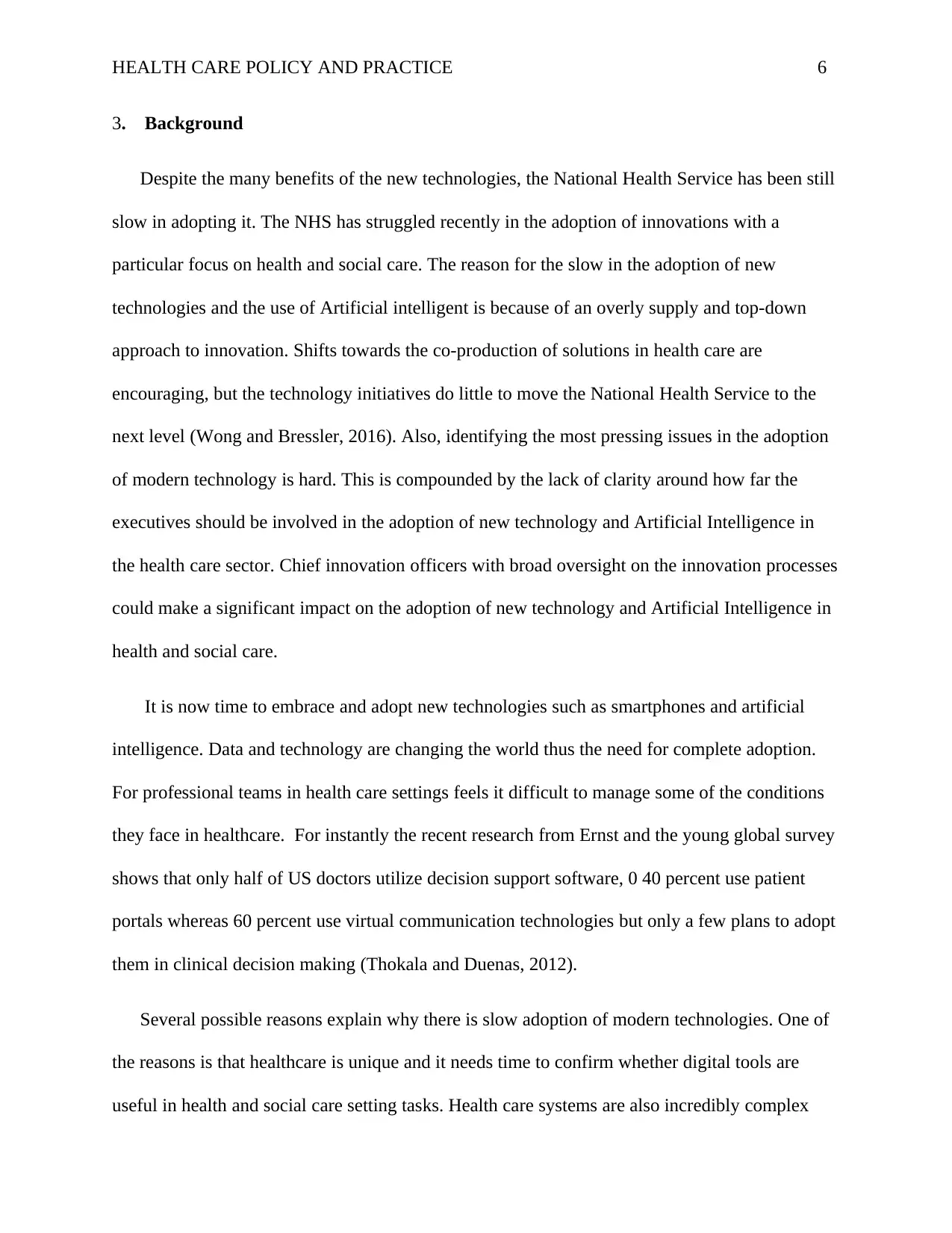
HEALTH CARE POLICY AND PRACTICE 6
3. Background
Despite the many benefits of the new technologies, the National Health Service has been still
slow in adopting it. The NHS has struggled recently in the adoption of innovations with a
particular focus on health and social care. The reason for the slow in the adoption of new
technologies and the use of Artificial intelligent is because of an overly supply and top-down
approach to innovation. Shifts towards the co-production of solutions in health care are
encouraging, but the technology initiatives do little to move the National Health Service to the
next level (Wong and Bressler, 2016). Also, identifying the most pressing issues in the adoption
of modern technology is hard. This is compounded by the lack of clarity around how far the
executives should be involved in the adoption of new technology and Artificial Intelligence in
the health care sector. Chief innovation officers with broad oversight on the innovation processes
could make a significant impact on the adoption of new technology and Artificial Intelligence in
health and social care.
It is now time to embrace and adopt new technologies such as smartphones and artificial
intelligence. Data and technology are changing the world thus the need for complete adoption.
For professional teams in health care settings feels it difficult to manage some of the conditions
they face in healthcare. For instantly the recent research from Ernst and the young global survey
shows that only half of US doctors utilize decision support software, 0 40 percent use patient
portals whereas 60 percent use virtual communication technologies but only a few plans to adopt
them in clinical decision making (Thokala and Duenas, 2012).
Several possible reasons explain why there is slow adoption of modern technologies. One of
the reasons is that healthcare is unique and it needs time to confirm whether digital tools are
useful in health and social care setting tasks. Health care systems are also incredibly complex
3. Background
Despite the many benefits of the new technologies, the National Health Service has been still
slow in adopting it. The NHS has struggled recently in the adoption of innovations with a
particular focus on health and social care. The reason for the slow in the adoption of new
technologies and the use of Artificial intelligent is because of an overly supply and top-down
approach to innovation. Shifts towards the co-production of solutions in health care are
encouraging, but the technology initiatives do little to move the National Health Service to the
next level (Wong and Bressler, 2016). Also, identifying the most pressing issues in the adoption
of modern technology is hard. This is compounded by the lack of clarity around how far the
executives should be involved in the adoption of new technology and Artificial Intelligence in
the health care sector. Chief innovation officers with broad oversight on the innovation processes
could make a significant impact on the adoption of new technology and Artificial Intelligence in
health and social care.
It is now time to embrace and adopt new technologies such as smartphones and artificial
intelligence. Data and technology are changing the world thus the need for complete adoption.
For professional teams in health care settings feels it difficult to manage some of the conditions
they face in healthcare. For instantly the recent research from Ernst and the young global survey
shows that only half of US doctors utilize decision support software, 0 40 percent use patient
portals whereas 60 percent use virtual communication technologies but only a few plans to adopt
them in clinical decision making (Thokala and Duenas, 2012).
Several possible reasons explain why there is slow adoption of modern technologies. One of
the reasons is that healthcare is unique and it needs time to confirm whether digital tools are
useful in health and social care setting tasks. Health care systems are also incredibly complex
⊘ This is a preview!⊘
Do you want full access?
Subscribe today to unlock all pages.

Trusted by 1+ million students worldwide
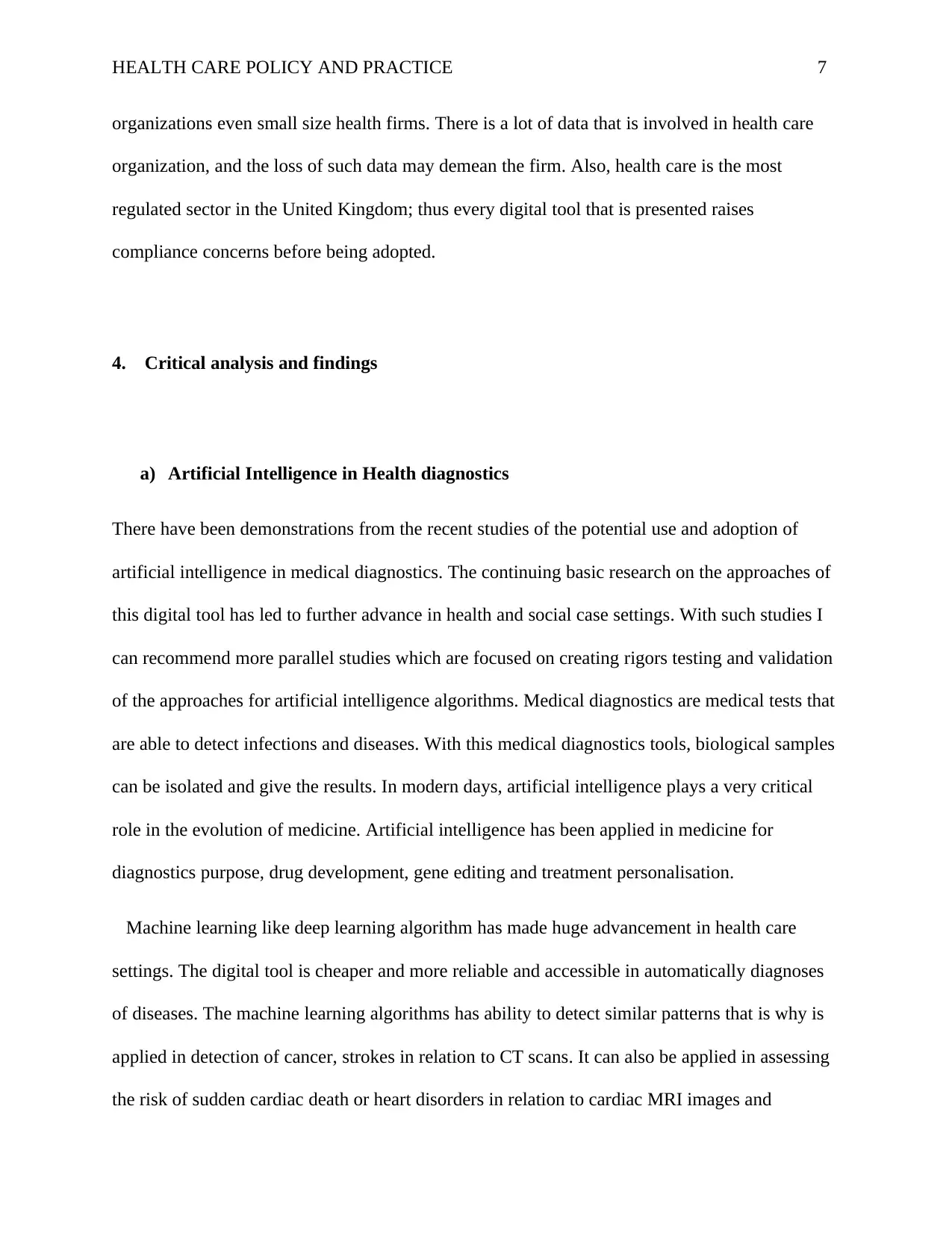
HEALTH CARE POLICY AND PRACTICE 7
organizations even small size health firms. There is a lot of data that is involved in health care
organization, and the loss of such data may demean the firm. Also, health care is the most
regulated sector in the United Kingdom; thus every digital tool that is presented raises
compliance concerns before being adopted.
4. Critical analysis and findings
a) Artificial Intelligence in Health diagnostics
There have been demonstrations from the recent studies of the potential use and adoption of
artificial intelligence in medical diagnostics. The continuing basic research on the approaches of
this digital tool has led to further advance in health and social case settings. With such studies I
can recommend more parallel studies which are focused on creating rigors testing and validation
of the approaches for artificial intelligence algorithms. Medical diagnostics are medical tests that
are able to detect infections and diseases. With this medical diagnostics tools, biological samples
can be isolated and give the results. In modern days, artificial intelligence plays a very critical
role in the evolution of medicine. Artificial intelligence has been applied in medicine for
diagnostics purpose, drug development, gene editing and treatment personalisation.
Machine learning like deep learning algorithm has made huge advancement in health care
settings. The digital tool is cheaper and more reliable and accessible in automatically diagnoses
of diseases. The machine learning algorithms has ability to detect similar patterns that is why is
applied in detection of cancer, strokes in relation to CT scans. It can also be applied in assessing
the risk of sudden cardiac death or heart disorders in relation to cardiac MRI images and
organizations even small size health firms. There is a lot of data that is involved in health care
organization, and the loss of such data may demean the firm. Also, health care is the most
regulated sector in the United Kingdom; thus every digital tool that is presented raises
compliance concerns before being adopted.
4. Critical analysis and findings
a) Artificial Intelligence in Health diagnostics
There have been demonstrations from the recent studies of the potential use and adoption of
artificial intelligence in medical diagnostics. The continuing basic research on the approaches of
this digital tool has led to further advance in health and social case settings. With such studies I
can recommend more parallel studies which are focused on creating rigors testing and validation
of the approaches for artificial intelligence algorithms. Medical diagnostics are medical tests that
are able to detect infections and diseases. With this medical diagnostics tools, biological samples
can be isolated and give the results. In modern days, artificial intelligence plays a very critical
role in the evolution of medicine. Artificial intelligence has been applied in medicine for
diagnostics purpose, drug development, gene editing and treatment personalisation.
Machine learning like deep learning algorithm has made huge advancement in health care
settings. The digital tool is cheaper and more reliable and accessible in automatically diagnoses
of diseases. The machine learning algorithms has ability to detect similar patterns that is why is
applied in detection of cancer, strokes in relation to CT scans. It can also be applied in assessing
the risk of sudden cardiac death or heart disorders in relation to cardiac MRI images and
Paraphrase This Document
Need a fresh take? Get an instant paraphrase of this document with our AI Paraphraser
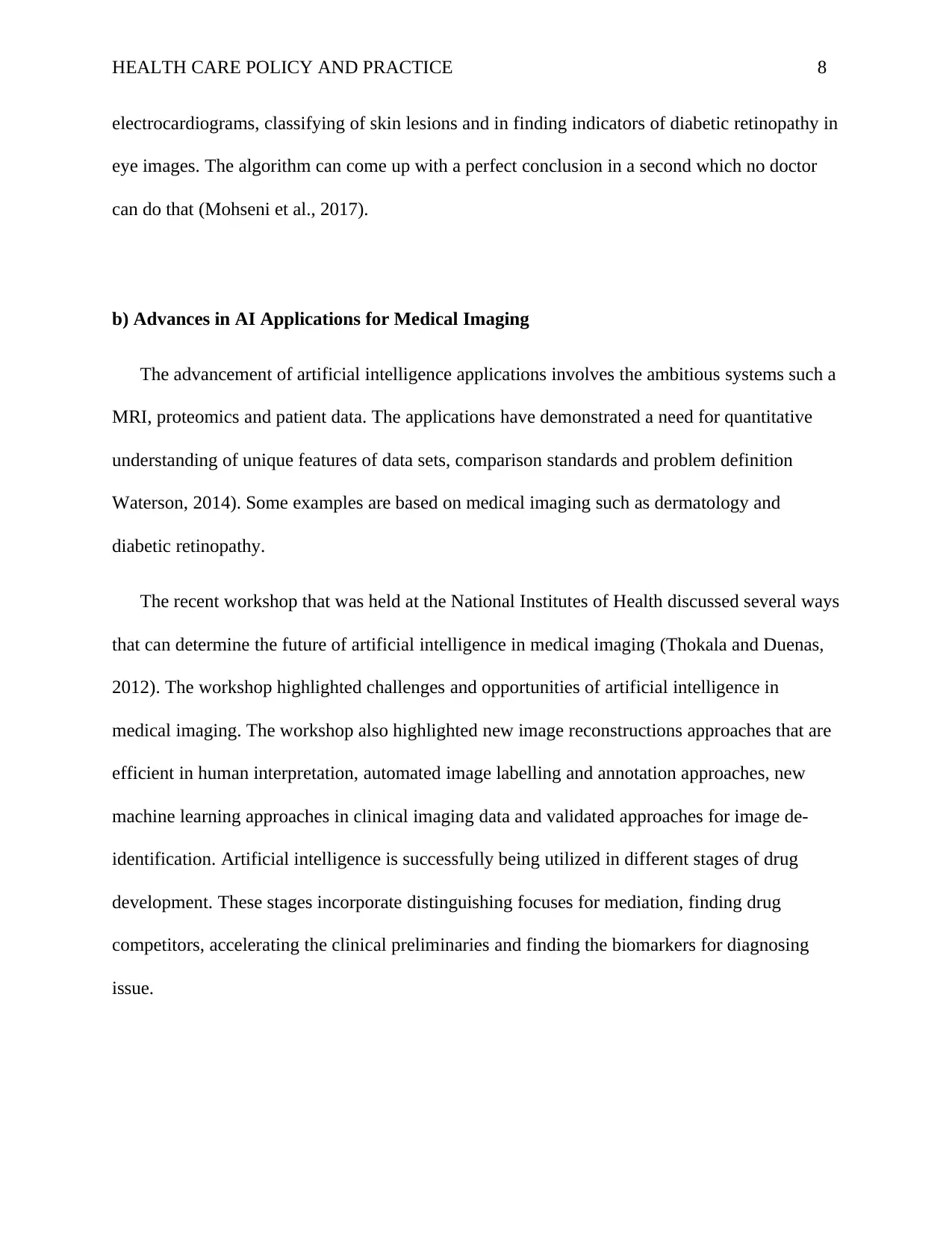
HEALTH CARE POLICY AND PRACTICE 8
electrocardiograms, classifying of skin lesions and in finding indicators of diabetic retinopathy in
eye images. The algorithm can come up with a perfect conclusion in a second which no doctor
can do that (Mohseni et al., 2017).
b) Advances in AI Applications for Medical Imaging
The advancement of artificial intelligence applications involves the ambitious systems such a
MRI, proteomics and patient data. The applications have demonstrated a need for quantitative
understanding of unique features of data sets, comparison standards and problem definition
Waterson, 2014). Some examples are based on medical imaging such as dermatology and
diabetic retinopathy.
The recent workshop that was held at the National Institutes of Health discussed several ways
that can determine the future of artificial intelligence in medical imaging (Thokala and Duenas,
2012). The workshop highlighted challenges and opportunities of artificial intelligence in
medical imaging. The workshop also highlighted new image reconstructions approaches that are
efficient in human interpretation, automated image labelling and annotation approaches, new
machine learning approaches in clinical imaging data and validated approaches for image de-
identification. Artificial intelligence is successfully being utilized in different stages of drug
development. These stages incorporate distinguishing focuses for mediation, finding drug
competitors, accelerating the clinical preliminaries and finding the biomarkers for diagnosing
issue.
electrocardiograms, classifying of skin lesions and in finding indicators of diabetic retinopathy in
eye images. The algorithm can come up with a perfect conclusion in a second which no doctor
can do that (Mohseni et al., 2017).
b) Advances in AI Applications for Medical Imaging
The advancement of artificial intelligence applications involves the ambitious systems such a
MRI, proteomics and patient data. The applications have demonstrated a need for quantitative
understanding of unique features of data sets, comparison standards and problem definition
Waterson, 2014). Some examples are based on medical imaging such as dermatology and
diabetic retinopathy.
The recent workshop that was held at the National Institutes of Health discussed several ways
that can determine the future of artificial intelligence in medical imaging (Thokala and Duenas,
2012). The workshop highlighted challenges and opportunities of artificial intelligence in
medical imaging. The workshop also highlighted new image reconstructions approaches that are
efficient in human interpretation, automated image labelling and annotation approaches, new
machine learning approaches in clinical imaging data and validated approaches for image de-
identification. Artificial intelligence is successfully being utilized in different stages of drug
development. These stages incorporate distinguishing focuses for mediation, finding drug
competitors, accelerating the clinical preliminaries and finding the biomarkers for diagnosing
issue.

HEALTH CARE POLICY AND PRACTICE 9
b) Detection of diabetic retinopathy in retinal fundus images
Early screening for diabetic retinopathy is critical. This is because early treatment can help in
the prevention of vision loss and blindness. This early treatment is significant especially to the
rapidly growing population of patients with condition of diabetes. Such screening also provides
the opportunity to determine the type of eye disorder and it also provides the indicator of any
cardiovascular condition (Chen, Chiang, and Storey, 2012).
e) Application of healthcare management
Patient self-management
The use of modern technology in health care settings is understood to support the patients in
the management of their conditions. Through the use of online health communities, patients can
share their experience, swap the management tips and support each other from medication
adherence. Also, from social care, patients can get information from websites and other resources
that can help them in the management of their chronic conditions (Riek, 2016).
To make good use of patient technology, our area can attempt to use the approved NHS
Apps in their library. One of the best apps that our town can use is GPs apps that are designed for
individuals with chronic conditions. Currently, none of these useful apps are being used in our
health care; thus there is the need for immediate adoption. One kind of technology that has been
used in some parts of the world is remote monitoring, and it has had positive impacts on people
able to manage their conditions. The app is useful in collecting necessary information from the
patient such as their blood glucose level or blood pressure (Ventola, 2014). The adoption of
b) Detection of diabetic retinopathy in retinal fundus images
Early screening for diabetic retinopathy is critical. This is because early treatment can help in
the prevention of vision loss and blindness. This early treatment is significant especially to the
rapidly growing population of patients with condition of diabetes. Such screening also provides
the opportunity to determine the type of eye disorder and it also provides the indicator of any
cardiovascular condition (Chen, Chiang, and Storey, 2012).
e) Application of healthcare management
Patient self-management
The use of modern technology in health care settings is understood to support the patients in
the management of their conditions. Through the use of online health communities, patients can
share their experience, swap the management tips and support each other from medication
adherence. Also, from social care, patients can get information from websites and other resources
that can help them in the management of their chronic conditions (Riek, 2016).
To make good use of patient technology, our area can attempt to use the approved NHS
Apps in their library. One of the best apps that our town can use is GPs apps that are designed for
individuals with chronic conditions. Currently, none of these useful apps are being used in our
health care; thus there is the need for immediate adoption. One kind of technology that has been
used in some parts of the world is remote monitoring, and it has had positive impacts on people
able to manage their conditions. The app is useful in collecting necessary information from the
patient such as their blood glucose level or blood pressure (Ventola, 2014). The adoption of
⊘ This is a preview!⊘
Do you want full access?
Subscribe today to unlock all pages.

Trusted by 1+ million students worldwide
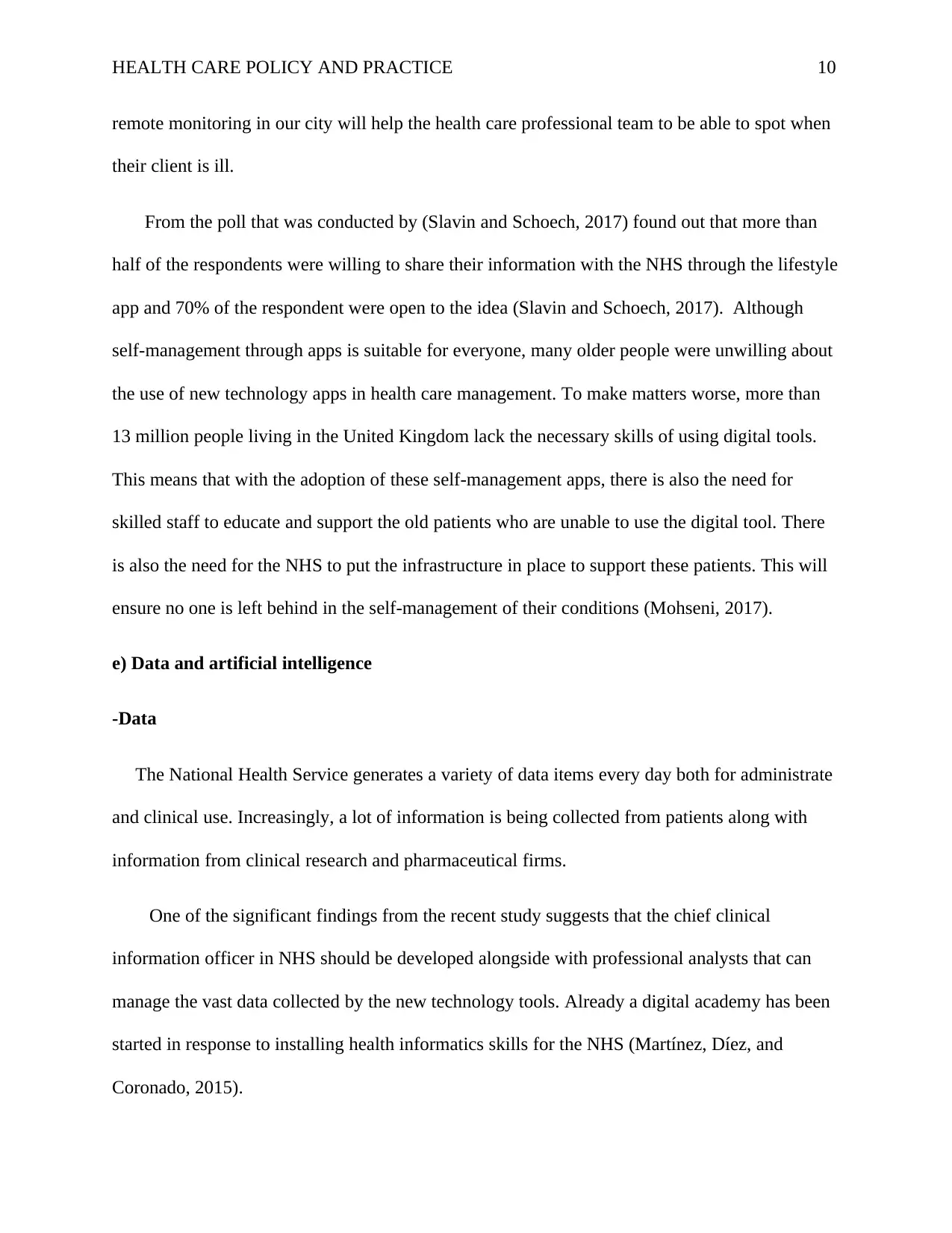
HEALTH CARE POLICY AND PRACTICE 10
remote monitoring in our city will help the health care professional team to be able to spot when
their client is ill.
From the poll that was conducted by (Slavin and Schoech, 2017) found out that more than
half of the respondents were willing to share their information with the NHS through the lifestyle
app and 70% of the respondent were open to the idea (Slavin and Schoech, 2017). Although
self-management through apps is suitable for everyone, many older people were unwilling about
the use of new technology apps in health care management. To make matters worse, more than
13 million people living in the United Kingdom lack the necessary skills of using digital tools.
This means that with the adoption of these self-management apps, there is also the need for
skilled staff to educate and support the old patients who are unable to use the digital tool. There
is also the need for the NHS to put the infrastructure in place to support these patients. This will
ensure no one is left behind in the self-management of their conditions (Mohseni, 2017).
e) Data and artificial intelligence
-Data
The National Health Service generates a variety of data items every day both for administrate
and clinical use. Increasingly, a lot of information is being collected from patients along with
information from clinical research and pharmaceutical firms.
One of the significant findings from the recent study suggests that the chief clinical
information officer in NHS should be developed alongside with professional analysts that can
manage the vast data collected by the new technology tools. Already a digital academy has been
started in response to installing health informatics skills for the NHS (Martínez, Díez, and
Coronado, 2015).
remote monitoring in our city will help the health care professional team to be able to spot when
their client is ill.
From the poll that was conducted by (Slavin and Schoech, 2017) found out that more than
half of the respondents were willing to share their information with the NHS through the lifestyle
app and 70% of the respondent were open to the idea (Slavin and Schoech, 2017). Although
self-management through apps is suitable for everyone, many older people were unwilling about
the use of new technology apps in health care management. To make matters worse, more than
13 million people living in the United Kingdom lack the necessary skills of using digital tools.
This means that with the adoption of these self-management apps, there is also the need for
skilled staff to educate and support the old patients who are unable to use the digital tool. There
is also the need for the NHS to put the infrastructure in place to support these patients. This will
ensure no one is left behind in the self-management of their conditions (Mohseni, 2017).
e) Data and artificial intelligence
-Data
The National Health Service generates a variety of data items every day both for administrate
and clinical use. Increasingly, a lot of information is being collected from patients along with
information from clinical research and pharmaceutical firms.
One of the significant findings from the recent study suggests that the chief clinical
information officer in NHS should be developed alongside with professional analysts that can
manage the vast data collected by the new technology tools. Already a digital academy has been
started in response to installing health informatics skills for the NHS (Martínez, Díez, and
Coronado, 2015).
Paraphrase This Document
Need a fresh take? Get an instant paraphrase of this document with our AI Paraphraser

HEALTH CARE POLICY AND PRACTICE 11
Currently, there is a big gap in NHS data remaining, and some of the critical information is
not readily available to the community, social and primary care. This gap is as a result of a lack
of a link from the national to community level. This means that there is a lot that needs to be
done and we can learn from nations such as Sweden and Denmark as they have successfully
collected comprehensive information and linked it (Lin and Roan, 2012). The abundance of
information is the driver of other development in health care, and it relies on the use of better and
advanced analytical tools in scientific discovery. Linking of comprehensive health care and
social data presents some benefits such as :
a) Reduction in variation in clinical practice- using digital technology in linking and analyzing
of data will give the health care professionals to understand and use the best practice protocols in
managing patient’s conditions. For example, if a client visits the hospital with suspected cancer,
the nurse can use the electronic health record to undertake every task in the protocol. With the
adoption of advanced digital technology, the physician can trigger the entire cancer workflow at
the click button and follow the protocol that is provided (Kyratsis, Ahmad and Holmes, 2012).
b) To understand how and why the disorders arise and how they can be detected and prevented-
root causes relates to how people live. Combining the social data with the clinical data on
diagnoses, treatment, and lifestyle can help in the likelihood of disorder within the society. This
means that with the support of digital technology, screening programmes can be put in place to
intervene in a particular condition (Krumholz, 2014).
c) Evaluate treatment outcomes and develop targeted treatment approaches- the linked data can
be utilized in complement evidence from trials carried out during the development stages of the
new drug. The linked data can also be used in consumer devices to monitor data from the society
Currently, there is a big gap in NHS data remaining, and some of the critical information is
not readily available to the community, social and primary care. This gap is as a result of a lack
of a link from the national to community level. This means that there is a lot that needs to be
done and we can learn from nations such as Sweden and Denmark as they have successfully
collected comprehensive information and linked it (Lin and Roan, 2012). The abundance of
information is the driver of other development in health care, and it relies on the use of better and
advanced analytical tools in scientific discovery. Linking of comprehensive health care and
social data presents some benefits such as :
a) Reduction in variation in clinical practice- using digital technology in linking and analyzing
of data will give the health care professionals to understand and use the best practice protocols in
managing patient’s conditions. For example, if a client visits the hospital with suspected cancer,
the nurse can use the electronic health record to undertake every task in the protocol. With the
adoption of advanced digital technology, the physician can trigger the entire cancer workflow at
the click button and follow the protocol that is provided (Kyratsis, Ahmad and Holmes, 2012).
b) To understand how and why the disorders arise and how they can be detected and prevented-
root causes relates to how people live. Combining the social data with the clinical data on
diagnoses, treatment, and lifestyle can help in the likelihood of disorder within the society. This
means that with the support of digital technology, screening programmes can be put in place to
intervene in a particular condition (Krumholz, 2014).
c) Evaluate treatment outcomes and develop targeted treatment approaches- the linked data can
be utilized in complement evidence from trials carried out during the development stages of the
new drug. The linked data can also be used in consumer devices to monitor data from the society
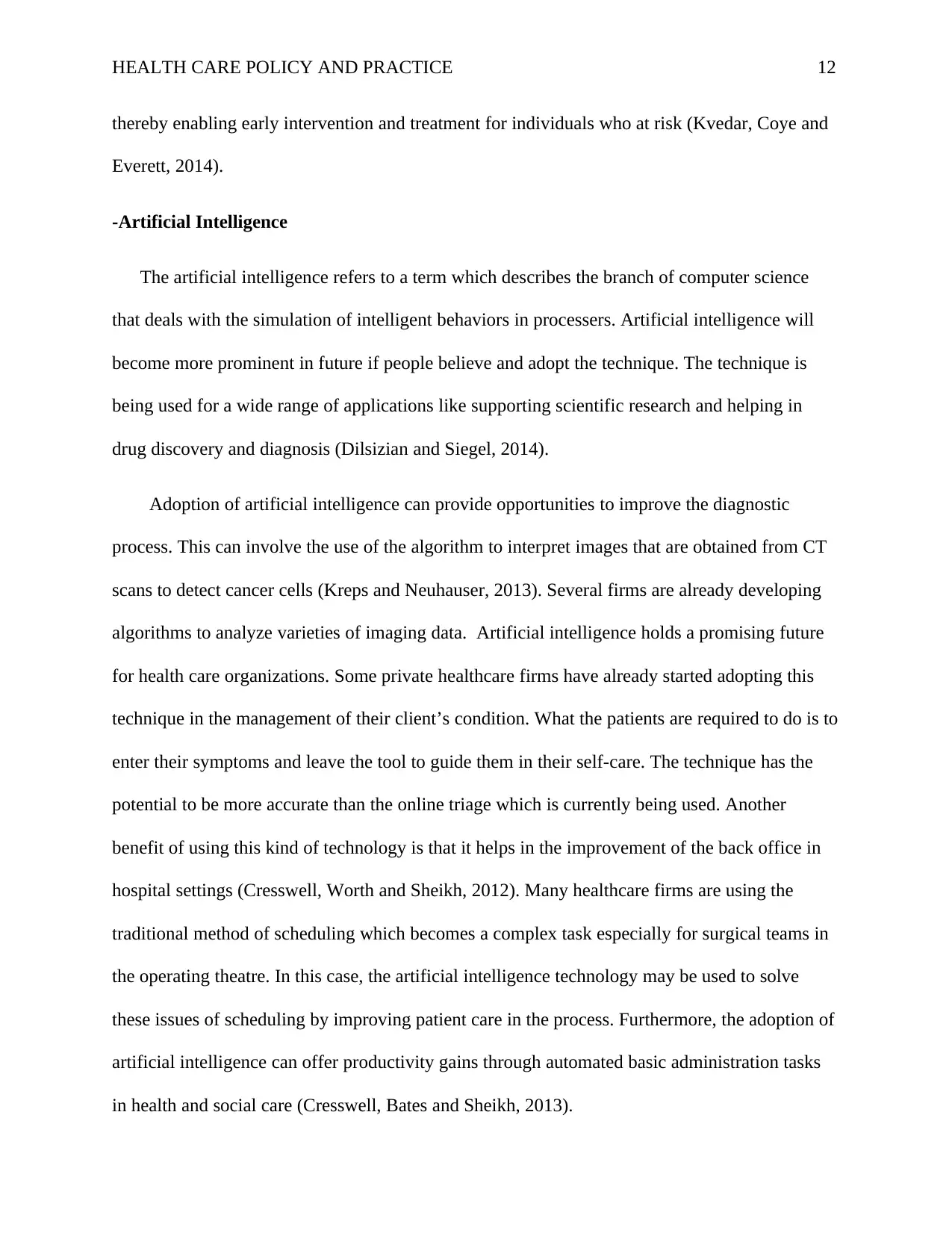
HEALTH CARE POLICY AND PRACTICE 12
thereby enabling early intervention and treatment for individuals who at risk (Kvedar, Coye and
Everett, 2014).
-Artificial Intelligence
The artificial intelligence refers to a term which describes the branch of computer science
that deals with the simulation of intelligent behaviors in processers. Artificial intelligence will
become more prominent in future if people believe and adopt the technique. The technique is
being used for a wide range of applications like supporting scientific research and helping in
drug discovery and diagnosis (Dilsizian and Siegel, 2014).
Adoption of artificial intelligence can provide opportunities to improve the diagnostic
process. This can involve the use of the algorithm to interpret images that are obtained from CT
scans to detect cancer cells (Kreps and Neuhauser, 2013). Several firms are already developing
algorithms to analyze varieties of imaging data. Artificial intelligence holds a promising future
for health care organizations. Some private healthcare firms have already started adopting this
technique in the management of their client’s condition. What the patients are required to do is to
enter their symptoms and leave the tool to guide them in their self-care. The technique has the
potential to be more accurate than the online triage which is currently being used. Another
benefit of using this kind of technology is that it helps in the improvement of the back office in
hospital settings (Cresswell, Worth and Sheikh, 2012). Many healthcare firms are using the
traditional method of scheduling which becomes a complex task especially for surgical teams in
the operating theatre. In this case, the artificial intelligence technology may be used to solve
these issues of scheduling by improving patient care in the process. Furthermore, the adoption of
artificial intelligence can offer productivity gains through automated basic administration tasks
in health and social care (Cresswell, Bates and Sheikh, 2013).
thereby enabling early intervention and treatment for individuals who at risk (Kvedar, Coye and
Everett, 2014).
-Artificial Intelligence
The artificial intelligence refers to a term which describes the branch of computer science
that deals with the simulation of intelligent behaviors in processers. Artificial intelligence will
become more prominent in future if people believe and adopt the technique. The technique is
being used for a wide range of applications like supporting scientific research and helping in
drug discovery and diagnosis (Dilsizian and Siegel, 2014).
Adoption of artificial intelligence can provide opportunities to improve the diagnostic
process. This can involve the use of the algorithm to interpret images that are obtained from CT
scans to detect cancer cells (Kreps and Neuhauser, 2013). Several firms are already developing
algorithms to analyze varieties of imaging data. Artificial intelligence holds a promising future
for health care organizations. Some private healthcare firms have already started adopting this
technique in the management of their client’s condition. What the patients are required to do is to
enter their symptoms and leave the tool to guide them in their self-care. The technique has the
potential to be more accurate than the online triage which is currently being used. Another
benefit of using this kind of technology is that it helps in the improvement of the back office in
hospital settings (Cresswell, Worth and Sheikh, 2012). Many healthcare firms are using the
traditional method of scheduling which becomes a complex task especially for surgical teams in
the operating theatre. In this case, the artificial intelligence technology may be used to solve
these issues of scheduling by improving patient care in the process. Furthermore, the adoption of
artificial intelligence can offer productivity gains through automated basic administration tasks
in health and social care (Cresswell, Bates and Sheikh, 2013).
⊘ This is a preview!⊘
Do you want full access?
Subscribe today to unlock all pages.

Trusted by 1+ million students worldwide
1 out of 18
Related Documents
Your All-in-One AI-Powered Toolkit for Academic Success.
+13062052269
info@desklib.com
Available 24*7 on WhatsApp / Email
![[object Object]](/_next/static/media/star-bottom.7253800d.svg)
Unlock your academic potential
Copyright © 2020–2025 A2Z Services. All Rights Reserved. Developed and managed by ZUCOL.





